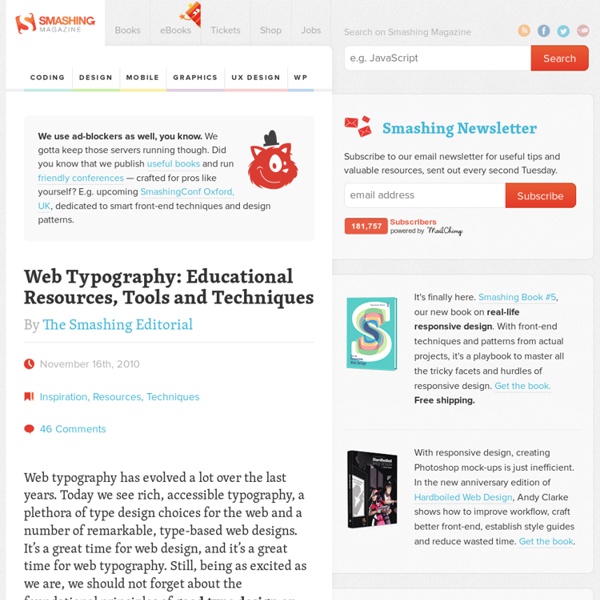



Download Free Fonts for Mac, Android, Windows | Font Cubes Lost Type Co-op A Beginner's Guide to Pairing Fonts – Web Design – Tuts+ Tutorials Pairing fonts can be a challenge. Selecting two or more fonts which work well is one thing - selecting two which work together to achieve your typographic aims may have you reaching for the aspirin. Let's see if we can alleviate any headaches. This guide will help you get started with font pairing for the web. Luckily, typography has been around a lo-oong time. Here's a quick breakdown of what we'll cover in this guide: Your Aim Keep the essentials in mind. How Many Fonts Should I Use? How many fonts you throw into the mix is entirely up to you, but bear in mind the overall effect you're trying to achieve. Make sure that there is some charisma in the group though; eight people with little to say just results in a toe-curling wait for the speeches.. It's no longer around, but the Fusion Ads 2011 bundle site sicks in my mind as a great example of successful stack-em-high font use. There are no rules to say you should or shouldn't use a specific number of fonts on a page layout. Quality.
dafont.com "What Font Should I Use?": Five Principles for Choosing and Using Typefaces Advertisement For many beginners, the task of picking fonts is a mystifying process. There seem to be endless choices — from normal, conventional-looking fonts to novelty candy cane fonts and bunny fonts — with no way of understanding the options, only never-ending lists of categories and recommendations. 1. Many of my beginning students go about picking a font as though they were searching for new music to listen to: they assess the personality of each face and look for something unique and distinctive that expresses their particular aesthetic taste, perspective and personal history. The most appropriate analogy for picking type. For better or for worse, picking a typeface is more like getting dressed in the morning. My “favorite” piece of clothing is probably an outlandish pair of 70s flare bellbottoms that I bought at a thrift store, but the reality is that these don’t make it out of my closet very often outside of Halloween. 2. 1. 2. 3. 4. 5. 3. 4. Time for another clothing analogy:
50 Helpful Typography Tools And Resources Advertisement We love beautiful typography, and we appreciate the efforts of designers who come up with great typographic techniques and tools or who just share their knowledge with fellow designers. We are always looking for such resources. We compile them, carefully select the best ones and then prepare them for our round-ups. To help you improve the typography in your designs, we’re presenting here useful new articles, tools and resources related to typography. You may be interested in the following related posts: Typography: References and Useful Resources The Taxonomy of TypeThis article’s purpose is to help us as designers to distinguish basic properties of types. Typedia: A Shared Encyclopedia of TypefacesTypedia is a resource to classify, categorize, and connect typefaces. Typeface Anatomy and GlossaryMany fonts have abbreviations in their names. Typographic Marks UnknownThere are many typographic marks which are familiar to most, but understood by few. Finding The Right Type
Typography In philately "typography", especially in the case of 19th century stamps, refers to letterpress printing. Typography is performed by typesetters, compositors, typographers, graphic designers, art directors, manga artists, comic book artists, graffiti artists, clerical workers, and everyone else who arranges type for a product. Until the Digital Age, typography was a specialized occupation. Digitization opened up typography to new generations of visual designers and lay users, and David Jury, Head of Graphic Design at Colchester Institute in England, states that “typography is now something everybody does.”[6] §History[edit] Printing press, 16th century in Germany The essential criterion of type identity was met by medieval print artifacts such as the Latin Pruefening Abbey inscription of 1119 that was created by the same technique as the Phaistos disc. Modern movable type, along with the mechanical printing press, is most often attributed to the goldsmith Johannes Gutenberg. §Scope[edit]